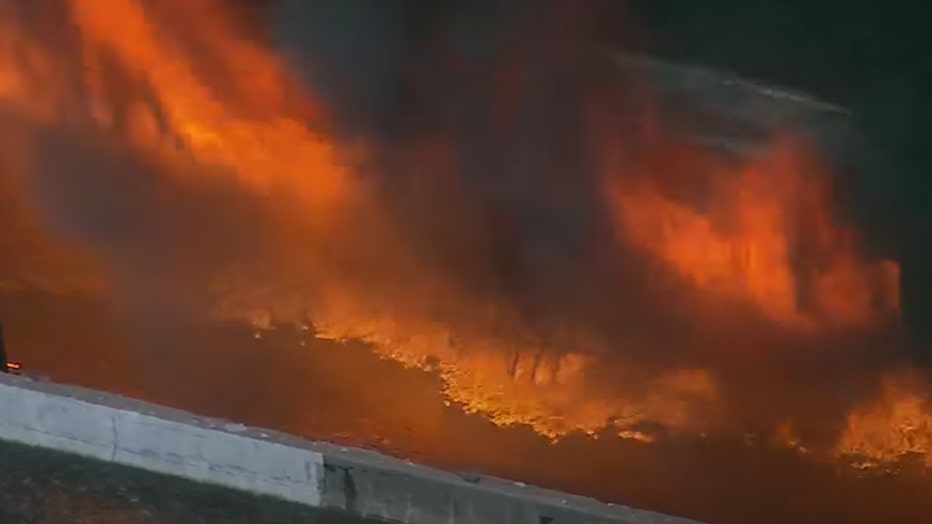What Philadelphia can learn from Atlanta's I-85 collapse
1 confirmed dead in Philly overpass collapse
FOX 5 learned one person has been confirmed dead after an overpass on Interstate 95 collapsed in Philadelphia. The body was discovered Monday afternoon.
A heavily traveled segment of Interstate 95 remains closed indefinitely in Philadelphia after an overpass section collapsed on Sunday following a fiery tanker truck crash. Pennsylvania's transportation officials will probably draw lessons learned from a similar incident in Atlanta in 2017.
On Thursday, March 30, 2017, a massive fire was intentionally set under a section of the Interstate 85 viaduct. As FOX5Atlanta.com streamed live coverage, the structure collapsed.
A 92-foot section of I-85 in between the Brookwood Exchange and Georgia 400 fell to the ground. Sections of both northbound and southbound spans had to be completely replaced.
Officials said they were able to pull all the firefighters out from under the overpass just before the collapse after noticing signs of fatigue in the structure. People stuck in the immediate area said they heard a loud rumble as the structure crashed to the ground.
The fire burned overnight and fire crews from Hartsfield-Jackson Atlanta International Airport had to be brought in to help extinguish the blaze.
The collapse impacted about 250,000 cars daily across the 10-lanes of traffic.
The closure put a strain on Interstates 75, 285, and Georgia 400 and flooded surface streets with people trying to find alternative routes. The collapse also closed Piedmont Road and the adjacent Buford Connector, which were adjacent to the fire location.
Schools closed, government offices shuttered their doors early for the weekend, and many government offices chose to open late. All levels of government were impacted by the disaster. Teleworking became the trend of the hour and there was a big push for commuters to take MARTA, the likes of which had not been seen since Atlanta hosted the 1996 Summer Olympic Games. MARTA showed a ridership increase of nearly 25% and an 80% increase in Breeze Card sales. Businesses in the area saw a 90% drop in traffic.
The so-called MARTA Army, a grassroots organization whose goal is to help improve Atlanta’s mass transit system, gathered volunteers over the weekend to post up at some of the busiest stations and stops around the service area to guide first-time riders.
Within a week, MARTA also offered a real-time parking tracker at their busiest stations to help riders.
Restrictions were also put into place to help prevent commuters from cutting through some of the nearby residential neighborhoods.
Despite everything, Atlantans found their sense of humor in posting memes and jokes about the collapse which was a source to ease the coming months of frustrations. Several businesses did their part to help as well. Atlanta-based Chick-fil-A even offered free breakfast for carpools with three or more people.
GDOT officials said in addition to the collapsed span, two other northbound spans and three southbound spans were damaged to the point of needing immediate replacement. It was a total of 350-feet northbound and 350-feet southbound spans which needed replacement along the viaduct.
Demolition began almost immediately as plans were drawn up to repair the section and the Georgia governor issued a state of emergency. Ultimately, C.W. Matthews Contracting Company was contracted at $15 million with a $3 million incentive bonus to complete the project by June 15. The federal government offered to pay $10 million of the repair costs.
After only 43 days, the busy highway reopened all northbound lanes. The next day, all southbound lanes reopened. What officials thought would take 10 weeks took only six.
The six-year anniversary of its reopening was celebrated just one month ago.
Investigators determined the fire under the overpass was set intentionally. The fire, which began with a chair on a shopping cart, ended up sparking a fire with plastic and fiberglass tubing stored in spools under the section of the viaduct by the Georgia Department of Transportation. A fence was erected around the area after the completion of the road project and officials worked to re-evaluate storage procedures.

Plastic and fiberglass spools stored under I-85 in Atlanta catch fire leading to the collapse of some spans on March 30, 2017. (FOX 5)
The suspects, all homeless, admitted to smoking crack before setting the fire. Their cases were transferred to drug court where they went through a rehab and diverse program.
BASIL ELEBY, ONCE ACCUSED IN I-85 OVERPASS COLLAPSE, REACHES MAJOR MILESTONE
Philadelphia deals with I-95 overpass collapse
Now the Northeast is dealing with a similar issue after a tanker truck caught fire in a crash at the Cottman Avenue exit along I-95, which happened just after 6:20 a.m. Sunday.
While this fire was fueled by 8,500 gallons of petroleum products, it still heated the overpass to the point it weakened, buckled, and fell.
In addition to the northbound lanes collapsing, the southbound lanes have been compromised and will also need replacing.
Unlike the I-85 collapse, the remains of the truck driver were found on Monday. Family identified him as Nathan S. Moody.
About 160,000 vehicles travel through this section of Philadelphia.
Pennsylvania Gov. Josh Shapiro has issued a disaster emergency in the county, and the National Transportation Safety Board will be conducting a safety inspection at the sight of the crash.
Bus routes and trash collection in the area will probably need to change.
SEPTA is also increasing service along the Trenton, West Trenton and Fox Chase Regional Rail lines.
There is no word yet on repair plans or a reopening date.
FOX 29 Philadelphia contributed to this report. This story is being reported out of Atlanta.

